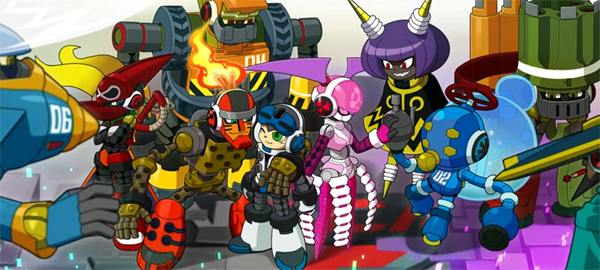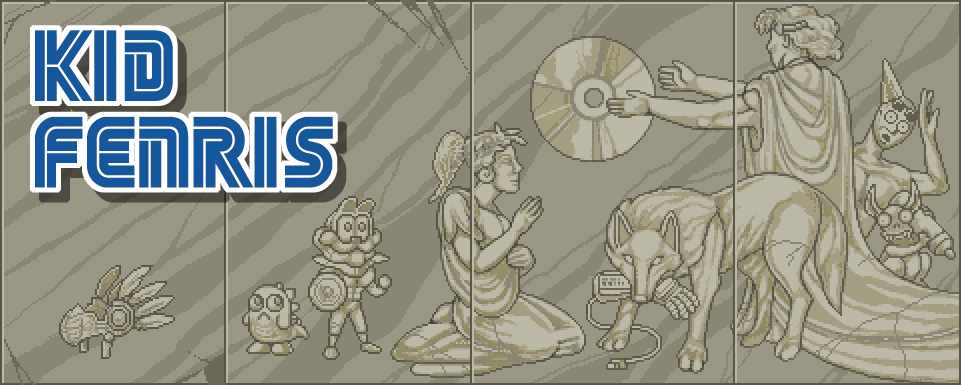Delays ensued, of course, and holes appeared with them. It was soon apparent that the final Mighty No. 9 wouldn’t look nearly as sharp as the Kickstarter mock-ups, and Inafune constantly got ahead of himself. He pitched a Mighty No. 9 animated series as well as two separate Kickstarters for Red Ash, a resuscitation of the Mega Man Legends sub-series. All of this came before Mighty No. 9 even arrived.

When Mighty No. 9 finally appeared, many pointed and laughed at a mediocre side-scroller. Technical hiccups abounded, trailers were terrible, the cutscenes looked amateurish, and the level design mostly rated somewhere between the humdrum Mega Man 6 and Mega Man X5. It's not the worst thing ever inflicted on Mega Man by a long shot, and it can be fun in that standard-issue Mega Man way. Yet it's a crippling disappointment for anyone who threw decent money at the Kickstarter and hoped for Mega Man's second coming.
There is, however, one part of Mighty No. 9 that I really like: the way it treats the bosses.
In both the artwork and the game proper, the rival Mighty robots are memorable crosses between the goofy look of older Mega Man bosses and the more heavily outfitted Mavericks from Mega Man X. They're covered in detail, from Aviator’s copter-Transformer theme to Countershade’s wide-disc hat and Daisuke Jigen goatee. In testament to Mighty No. 9’s presumption, they’re perfect for a toy line that’ll never be made. I’d buy every one of them. Even the pacifier-sucking Cryo.

Mighty No. 9 makes plain that hero Beck is fighting to free his virally corrupted Mighty comrades. Once liberated, they’ll show up to help Beck in other stages: Dynatron will defuse electric traps in a capitol building, while Battalion might clear a cavern of enemies. Most of the Mighties have cornball personalities, but that makes it even more precious when they come to your aid.
It’s the most satisfying thing about Mighty No. 9, wan praise as that is. It's also part of a quiet trend in the entire Mega Man series.
In healthier times, each Mega Man title pushed a fresh lineup of Robot Masters, but rarely did they develop. For a line of games so clearly rooted in Osamu Tezuka’s Astro Boy, the majority of Mega Man tales don’t spare great pity for his foes, not even when they’re presumably upright robots reprogrammed by recurring ne’er-do-well Dr. Wily. Later Mega Man X outings put some tragic flourishes on the level bosses, but it’s a general Mega Man rule that the antagonists are just there to be destroyed, to yield their weapons to our hero without stirring compunction.

The balance shifted in Mega Man: Powered Up, a PSP recast of the original Mega Man with cuter characters, two new bosses, and plenty of extras. It also re-imagines the roles of the original game’s Robot Masters, creations of Dr. Light corrupted by Wily’s machinations. No longer silent obstacles, the stage bosses now banter with Mega Man before the fight. Cut Man is even convinced that Mega Man is “a bad robot” and vows “I’ll make you good again!”
If it sounds pathetic, that’s the idea. You can squash Powered Up’s bosses by exploiting their weaknesses to specific weapons, but using only Mega Man’s stock Buster shot incapacitates them and allows Dr. Light to return them to normal. And for those who sneer at virtue being its own reward, Powered Up offers a bonus: removed from Wily’s control, the bosses become playable characters in the same capacity as Mega Man.
This broadens Powered Up significantly, both in its play mechanics and in those little touches that turn good games into favorites. It’s reason enough to lament the lack of any more Powered Up remakes. Were fans put off by the game’s ultra-cutesy characters, even though they don’t play as awkward as they look? Or was it just that Oil Man, one of the new bosses, had big racist golliwog lips and that the Mega Man comic had to wrap a scarf around him?
An underlying empathy also runs through Mega Man 9, which strove to paint an NES sidescroller with modern details. Another batch of Light’s robots goes berserk, and a Tezuka-grade twist reveals that all of the rebellious Robot Masters were scheduled to be scrapped. The machines didn’t mind their fate so much, but Wily convinced them that his modifications would let them continue to serve humanity.

The bosses of Mega Man 9 are well-meaning dupes, and the game remembers this. After Mega Man defeats Wily yet again, the ending credits show the apparently rebuilt Robot Masters palling around with other Mega Man characters. Plug Man and Rush raid Akihabara shops, Hornet Man waters flowers alongside Beat, and Splash Woman poses for beachside photos with Auto. Yes, Mega Man games are driven by stereotypes.
More importantly, recent Mega Man games are driven by an urge to redeem enemies. And why not? These aren’t despondent Yasumi Matsuno strategy-RPGs, after all. Mega Man adventures are innocent tales despite the occasional doses of war-weary melodrama, and it’s important to keep them lighthearted. In cynical terms, it also gives Capcom more cause to turn the bosses into toys and other merchandise.
In fact, mollified bosses go back as far as the NES games, if only in their tangents. An illustration from the Mega Man 3 manual shows all of the bosses from the previous two games crowding together happily, except for grumpy old Cut Man.

Perhaps it’s just my childhood guilt from destroying enemies, but I like that image. While it has no influence on the game itself, it's reassuring. Like a curtain call after a gruesome play, it’s a reminder that everyone’s just fine off-stage. Mighty No. 9 is better for embracing that, no matter how else it disappoints.

Aside from the technical issues that killed me a few times while playing, I wasn't really that down on Mighty No. 9. It was clearly the bosses that won me over, though. The first time I saw a boss pop up in another boss' stage took me completely off guard. They were actual characters who did helpful things! Building off of this would be the best thing to do for a sequel...that looks like it may never happen.
ReplyDeleteAlso, playing as Ray turns the game into Mega Man Zero, and it's a much more coherent game.
You should read the Mega Man Megamix and Gigamix manga by Hitoshi Ariga if you haven't. The boss robots not only have distinct personalities but get to hang out indefinitely as part of an extended supporting cast rather than be killed off. The MM1 bosses even get reformed and return to Dr. Light's lab.
ReplyDelete